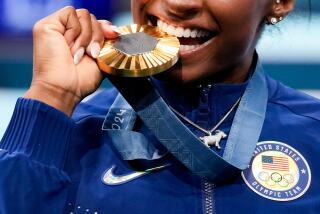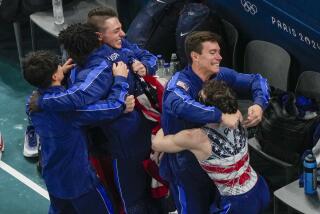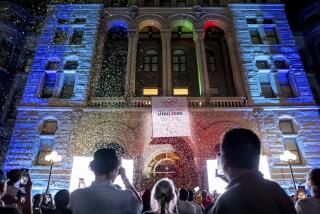Olympic Medals to Be Homegrown
SALT LAKE CITY — When skier Donna Weinbrecht got her first glimpse of the medals that will be awarded at the Salt Lake City Olympics, she cried.
The five-time World Cup champion is no stranger to Olympic medals--after all, she won gold in moguls at the 1992 Olympics in Sarajevo.
Yet she was moved to tears by Salt Lake’s hand-crafted medals, which are made from native materials and look more like fine sculpture than the traditional prizes draped around the necks of the world’s finest athletes.
The design is unique. Usually, Olympic medals look like big coins, but Salt Lake’s resemble weathered stones plucked from a mountain stream.
They are the largest and heaviest and the most customized, with pictograms for each of 16 winter sports. No two are exactly alike; handcrafting ensures each medal varies in thickness, width and finish.
“They put so much passion into such a meaningful medal,” said Weinbrecht, who is attempting a comeback at the Feb. 8-24 games.
If she could win just one more Olympic medal, she said, “this would be it -- a beautiful medal from a country that gives me the freedom to be a woman at 36 going for her fourth Olympics.”
These gold, silver and bronze medals are exclusively Utah, extracted from minerals donated by Kennecott Corp., from the world’s largest open-pit mine near Salt Lake City; designed by a team of artists led by Utah native Brent Watts; and produced by O.C. Tanner, which is still milling, shaping and polishing the last of 816 medals, including archive copies.
Each medal requires about 20 hours of work.
“It’s been fun. I love the Olympics,” said Steve O’Brien, pouring a pot of molten gold into a vat of water. That produces gold pellets, which later are made into long, thin gold bars. Those bars become the plating for the gold medals.
“It makes you feel proud. When some athlete puts on a medal, I’ll know I had something to do with it,” he said.
In a design room, Patrik Warren showed how he scanned the texture of a plaster mold into a computer, turning delicate edges and shapes into 2 million lines of software code needed to cut a 26-pound die for the medals’ basic features. Even then, Gary Felice had to perfect the die’s intricate details with a tiny, diamond-tipped hand drill.
More to Read
Go beyond the scoreboard
Get the latest on L.A.'s teams in the daily Sports Report newsletter.
You may occasionally receive promotional content from the Los Angeles Times.






